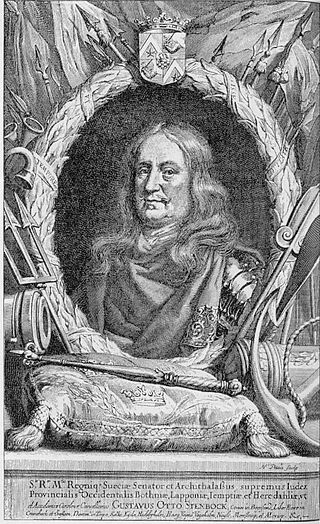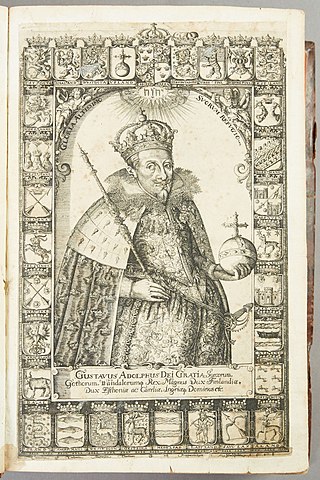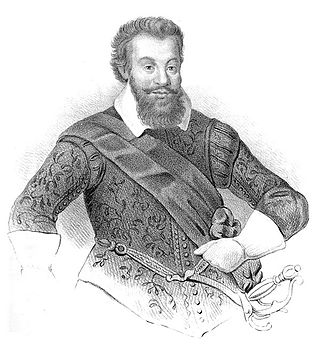
Axel Gustafsson Oxenstierna was a Swedish statesman and Count of Södermöre. He became a member of the Swedish Privy Council in 1609 and served as Lord High Chancellor of Sweden from 1612 until his death. He was a confidant of King Gustavus Adolphus and then Queen Christina, for whom he was at first regent.

John III was King of Sweden from 1569 until his death. He attained the Swedish throne after a rebellion against his half-brother Erik XIV. He is mainly remembered for his attempts to close the gap between the newly established Lutheran Church of Sweden and the Catholic Church, as well as his conflict with and possible murder of his brother.
The Council of the Realm, or simply The Council, was a cabinet of medieval origin, consisting of magnates which advised, and at times co-ruled with, the King of Sweden.

Baron Gabriel Gustafsson Oxenstierna was a Swedish statesman.

Count Gustav Horn was a Swedish nobleman of Finnish descent, military officer, and Governor-General. He was appointed member of the Royal Council in 1625, Field Marshal in 1628, Governor General of Livonia in 1652 and Lord High Constable since 1653. In the Thirty Years' War (1618–1648), he was instrumental as a commander in securing victory at the Battle of Breitenfeld, in 1631. He was High Councillor of the realm in 1625, elevated to the rank of field marshal in 1628, and sometimes commander-in-chief of Swedish forces in Germany during Thirty Years' War. After the war, he served as Governor-General of Livonia 1652, President of War department and Lord High Constable in 1653. In 1651, Queen Christina created him Count of Björneborg.

Gustaf Otto Gustafsson Stenbock was a Swedish military officer and politician.

Swedish Livonia was a dominion of the Swedish Empire from 1629 until 1721. The territory, which constituted the southern part of modern Estonia and the northern part of modern Latvia, represented the conquest of the major part of the Polish-Lithuanian Duchy of Livonia during the 1600–1629 Polish-Swedish War. Parts of Livonia and the city of Riga were under Swedish control as early as 1621 and the situation was formalized in the Truce of Altmark 1629, but the whole territory was not ceded formally until the Treaty of Oliva in 1660. The minority part of the Wenden Voivodeship retained by the Polish–Lithuanian Commonwealth was renamed the Inflanty Voivodeship, which today corresponds to the Latgale region of Latvia.

The Swedish nobility has historically been a legally or socially privileged class in Sweden, and part of the so-called frälse. The archaic term for nobility, frälse, also included the clergy, a classification defined by tax exemptions and representation in the diet. Today the nobility does not maintain its former legal privileges although family names, titles and coats of arms are still protected. The Swedish nobility consists of both "introduced" and "unintroduced" nobility, where the latter has not been formally "introduced" at the House of Nobility (Riddarhuset). The House of Nobility still maintains a fee for male members over the age of 18 for upkeep on pertinent buildings in Stockholm.

Swedish Ingria was a dominion of the Swedish Empire from 1583 to 1595 and then again from 1617 to 1721 in what is now the territory of Russia. At the latter date, it was ceded to the Russian Empire in the Treaty of Nystad, at the end of the Great Northern War between the two empires.

The Duchy of Estonia, also known as Swedish Estonia, was a dominion of the Swedish Empire from 1561 until 1721 during the time that most or all of Estonia was under Swedish rule. The territory was eventually ceded to Russia in the Treaty of Nystad, following its capitulation during a plague outbreak in the Great Northern War.
The Lord High Constable was a prominent and influential office in Sweden, from the 13th century until 1676, excluding periods when the office was out of use. The office holder was a member of the Swedish Privy Council and, from 1630 and on, the head of the Swedish Council of War. From 1634, the Lord High Constable was one of five Great Officers of the Realm.

The Kurki family or Kurck, also known as the family of Laukko, is a Finnish noble family tracing its lineage back to the late 14th century. It produced several historically prominent persons. The family is usually divided into several lineages, as it continued through female succession.

The Lord of the Realm was a title of honour introduced by Gustavus III, King of Sweden shortly after his coup and the newly passed constitution. The title was granted by the King and was first received by Frederick William, Prince von Hessenstein on 15 January 1773 by letter. One of the most famous title holders was Hans Axel, Count von Fersen, the supposed lover and confidant of Marie Antoinette, Queen of France.

The first duke of Estonia was appointed in 1220 by King Valdemar II of Denmark after the Danish conquest of Estonia during the Livonian crusade. The title was resumed by the kings of Denmark since 1269. During the 1266-82 reign of the queen dowager Margaret Sambiria, the title lady of Estonia was used.

Elsa Elisabeth Brahe, was a Swedish countess and duchess, married to Adolph John I, Count Palatine of Kleeburg, Duke of Stegeborg, the brother of king Charles X of Sweden.

Axel Nilsson Ryning, born 1552, died 8 January 1620, was a Swedish Lord High Admiral, Marshal, Councilor, and Baron to Tuna farm in Österåker parish in the current Österåker municipality in Österskär in Åkersberga, Stockholm county. Son of Nils Eriksson Ryning and Ingeborg Trolle.












